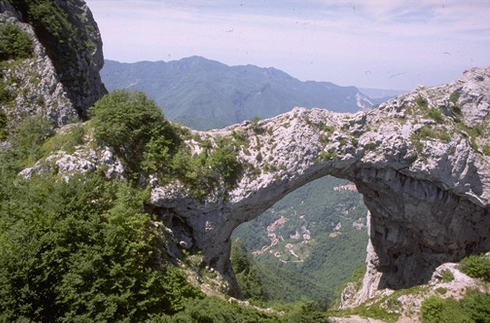
Regional Park of the Apuan Alps
This post is also available in:
 Italiano (Italian)
Italiano (Italian)
The Regional Park of the Apuan Alps was established in 1985 and it is located between the provinces of Lucca and Massa-Carrara. The Apuan Alps are distinguished from the nearby Apennines by their very harsh morphology, with deeply carved valleys and imposing steep slopes. In addition to its wealth of marble and other beautiful building stones (“cipollino”, “brecce”, “Cardoso”, etc.), the Apuan Alps are known for their great variety of landscapes and, needless to say, their wealth of flowers, plants and animals.
This mountain range also shows remarkable geomorphological features: moraines, erratic boulders, valleys and rock circles; surface karstic formations, such as limestone pavements, and sinkholes; in the subsoil, there are many deep gorges and the great Apuan cavities, a labyrinth of tunnels and wells: the Antro del Corchia, for instance, with over 43 miles of underground galleries and, reaching the height of 3.969 ft, is the largest karstic system in Italy and one of the biggest in the world.
FLORA
On the hills exposed to the sea, the vegetation is of the Mediterranean type, with holm oaks (Quercus ilex), myrtle (Myrtus communis), turpentine trees (Pistacia terebinthus), and mock privets (Phillirea latifolia).
As the altitude increases, there are oak-hornbeams groves with black hornbeams (Ostrya carpinifolia), downy oaks (Quercus pubescens), and Fraxinus ornus; righ there, some of the endemic species of the Apuan Alps are abundant, like globe daisies (Globularia incanescens), lavender-cotton (Santolina leucantha), ox-eyes (Buphthalmum salicifolium subsp. flexile), moltkias (Moltkia suffruticosa), and mouse-ear chickweeds (Cerastium apuanum). At higher altitudes, there are common beech forests, dominated by the Fagus sylvatica.
FAUNA
Thanks to the protection offered by this area, wildlife has significantly increased: golden eagles have returned, and, among birds of prey, there are numerous peregrine falcons, kestrels, buzzards, owls, the barn owls, long-eared owls and little owls.
Geomorphologically speaking, there is no shortage of well-preserved examples of moraines, erratic boulders, valleys and rock circles of the last Wyrmian glaciation. Surface karstic formations are also abundant, such as limestone pavements, sinkholes (Carcaraia, Mount Altissimo, Mount Sagro, etc.) and other phenomena of epigeal dissolution (Vetricia plateau; the arch of Mount Forato, etc.).
In the subsoil, some great karstic phenomena are often observed; in the subsoil, there are many deep gorges and the great Apuan cavities, a labyrinth of tunnels and wells: the Antro del Corchia, for instance, with over 43 miles of underground galleries and, reaching the height of 3.969 ft, is the largest karstic system in Italy and one of the biggest in the world.
One of the most surprising features of the Apuan Alps is represented by the exceptional variety of spontaneous flora, which features about two-thirds of the plant species present in the whole peninsula. The park also includes over 1.300 caves of various sizes, mostly accessible only with professional gear and a speleological guide.
This post is also available in:
 Italiano (Italian)
Italiano (Italian)
Contatti
Via Corrado Del Greco 11 - Seravezza(LU)
0584 75821
info@parcapuane.it




